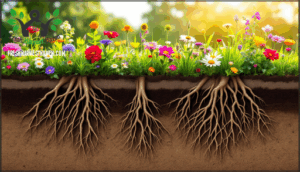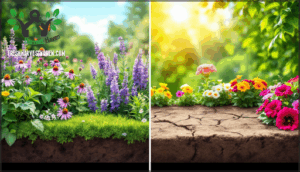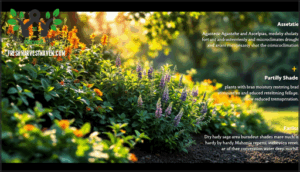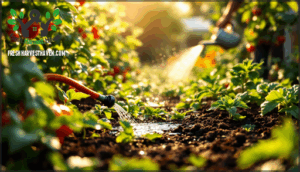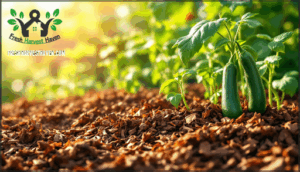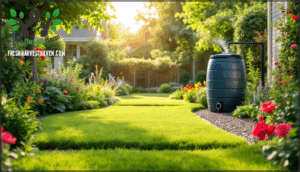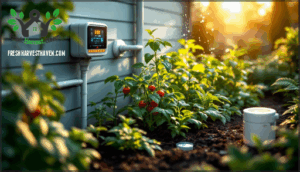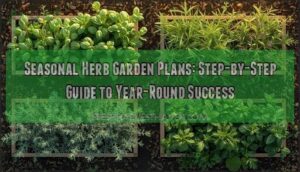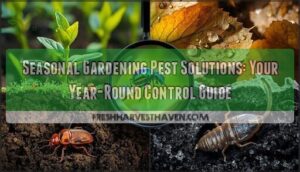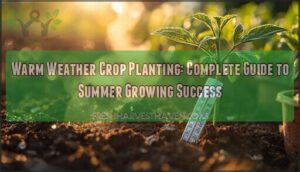This site is supported by our readers. We may earn a commission, at no cost to you, if you purchase through links.
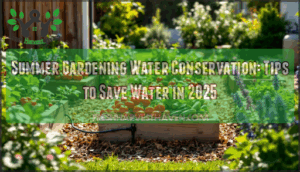
The good news: smart summer gardening water conservation cuts your usage by 50 percent or more without sacrificing plant health. Native species, efficient irrigation, and strategic mulching transform your landscape into a self-sustaining ecosystem that thrives on less.
These methods save money, protect local water supplies, and actually produce stronger plants with deeper roots and better drought resistance.
Table Of Contents
- Key Takeaways
- Choose Drought-Tolerant Plants
- Optimize Watering Techniques
- Use Mulching to Retain Moisture
- Reduce Lawn Size and High-Water Areas
- Install Water-Saving Tools and Systems
- Frequently Asked Questions (FAQs)
- How often should containers be watered daily?
- What soil amendments improve water retention naturally?
- When should rainwater harvesting systems be installed?
- How do wind barriers reduce garden evaporation?
- Which companion plants share water most efficiently?
- How often should I check soil moisture levels?
- Can greywater be safely used for edible plants?
- What soil amendments improve water retention best?
- How do I calculate my gardens water needs?
- When should I adjust watering for seasonal changes?
- Conclusion
Key Takeaways
- Native and drought-tolerant plants with deep root systems (up to 10 feet) reduce irrigation needs by 60-70% once established, saving homeowners around $46 annually while requiring watering just once weekly or less during summer heat.
- Drip irrigation achieves 90% water efficiency compared to sprinklers’ 50-70% efficiency, cutting overall water use by up to 80% while costing significantly less to install ($310-$815 versus $2,500-$4,000 for sprinkler systems).
- Applying 2-4 inches of organic mulch like wood chips or compost reduces soil water evaporation by up to 70% and suppresses weeds by 80%, creating a self-regulating system that requires less frequent watering and maintenance.
- Replacing traditional turf with native meadow lawns or hardscaping elements slashes outdoor water consumption by 40-80%, with some homeowners saving 60 gallons per square foot yearly while cutting maintenance time by 75%.
Choose Drought-Tolerant Plants
The right plant choices can slash your watering duties while keeping your garden thriving through summer’s heat. Some species naturally handle dry spells better than others, making them smart picks for water-conscious gardeners.
Here’s what to think about when selecting plants that won’t leave you chained to the hose.
Native Plants and Their Water Needs
Native plants are climate adaptation champions. Their deep root systems—reaching up to 10 feet compared to turf’s shallow 1–2 feet—access underground moisture and reduce irrigation needs by 70%. Once established, these drought-resistant plants require watering just once weekly or less, delivering water savings of 60% annually. You’ll save around $46 per year on water costs while supporting native plant landscaping that’s built for your region’s conditions.
Native plants’ deep roots reach ten feet down, slashing irrigation needs by 70% while saving you money and water year-round
A study showed that watering frequency impacts plant biomass production.
Perennials Versus Annuals for Water Savings
Perennials versus annual flowers isn’t just about bloom time—it’s a water efficiency showdown. Perennial plants develop root systems up to four times deeper than annuals, accessing subsoil moisture and cutting irrigation frequency by 40% once established.
Their year-round root zones reduce water runoff by 15–25% and improve soil structure, retaining 20–30% more available water. These plants also help with carbon dioxide sequestration.
Established perennial gardens slash landscape water needs by 70% compared to annual beds—a major shift for waterwise gardening and climate adaptation with lasting soil erosion protection.
Sun-Loving and Shade-Tolerant Varieties
Matching plant selection to your yard’s microclimate zones—sun vs shade—cuts irrigation needs by 20–40% while boosting growth performance. Full-sun plants like Echinacea and Penstemon develop thick cuticles and deep roots, thriving without frequent watering once established. For dry shade under trees, choose Epimedium or Asarum canadense—their fibrous roots handle root competition better.
Here’s your summer gardening plant selection guide for conserving water with drought-resistant plants:
- Sun lovers: Agastache, Asclepias (native adaptations to heat)
- Partial shade: reduced transpiration, 30% longer moisture retention
- Dry shade specialists: Mahonia repens, deep mulch required
- Native perennials: roots reach 2+ meters for water efficiency
- Microclimate effects: shaded zones need half the irrigation frequency
Optimize Watering Techniques
Regarding watering, timing and method make all the difference. The way you deliver water to your plants can save thousands of gallons each season while keeping your garden healthier.
Let’s look at the most effective watering techniques you can put into practice this summer.
Early Morning Watering Benefits
Watering before 9 a.m. cuts evaporation by up to 50% because cooler temperatures keep moisture from escaping into the air. This ideal watering time boosts plant health by improving root uptake and promotes disease prevention—morning moisture dries quickly, reducing fungal problems by 40%.
These efficient watering methods align with conservation goals while saving you thousands of gallons each season.
Drip Irrigation Vs. Sprinklers
Drip irrigation achieves 90% water efficiency compared to sprinklers’ 50–70%, cutting water use by up to 80%. This efficient irrigation method operates at lower pressure, reducing energy consumption by 30–50%.
Installation costs range from $310–$815 for drip systems versus $2,500–$4,000 for sprinklers.
Drip irrigation also improves soil health by minimizing nutrient leaching and promotes better crop yields through consistent root-zone moisture delivery.
Proper Sprinkler Positioning and Coverage
Even with sprinklers, proper sprinkler positioning guarantees waste prevention and protects your landscape. Position heads to assure coverage uniformity across planting beds, spacing them based on your water pressure and equipment specifications. Residential spray heads work best at 10–15 feet apart, while rotors need 25–40 feet for efficient irrigation.
- Place heads at least 18 inches from buildings to prevent water damage and mold growth
- Adjust sprinkler spacing in windy areas, reducing distances by 25% to compensate for drift
- Direct spray away from driveways and sidewalks to minimize runoff, which wastes up to 15% of water
- Use head-to-head coverage, where each sprinkler’s spray reaches the next head for uniform distribution
- Check that water pressure stays between 30–60 PSI to maintain consistent throw and avoid dry spots
Smart landscape placement and runoff reduction strategies assure your sprinkler systems deliver water where plants need it most.
Avoiding Overwatering and Water Waste
How often does waterlogging signal trouble? Overwatering reduces root oxygenation by 30–50%, creating soil saturation that invites root rot and disease. Watch for pooling water—it reveals poor drainage and wasted resources.
Smart controllers adjust watering schedules based on weather data, cutting water consumption by up to 20%. Fix irrigation leaks promptly; a single broken head wastes 25,000 gallons yearly.
Efficient irrigation means deep, infrequent watering that promotes runoff reduction and healthier root systems.
Use Mulching to Retain Moisture
Mulching is one of the simplest ways to lock moisture into your soil and cut down on watering. The right material, applied at the proper depth, creates a protective barrier that keeps roots cool and hydrated.
Let’s look at how to use mulch effectively to reduce evaporation and keep weeds at bay.
Best Organic Mulch Materials
Not all mulch works the same way—some materials act like a sponge for your soil, while others just sit there looking pretty. Wood chips and compost mulch lead the pack, cutting water loss by up to 70% in summer heat. Straw mulch keeps soil temperatures cooler and blocks weeds effectively. Leaf litter and newspaper mulch also retain moisture well, though they break down faster.
These natural mulch options add organic matter as they decompose, improving your soil while conserving water.
Correct Mulch Depth and Application
Applying mulch at the right depth makes a big difference—two to three inches work best for flower beds, while trees need three to four inches. Vegetable gardens do well with just one to two inches so roots can breathe.
Spread it evenly, but keep a two-inch gap around plant stems to prevent rot. One cubic yard covers 162 square feet at two inches depth, helping you plan your water-saving project efficiently.
Mulching to Reduce Weeds and Evaporation
Think of mulch as a protective shield—it blocks sunlight that triggers weed germination while keeping soil moisture locked in place. A proper layer cuts evaporation by up to 58.8%, meaning you’ll water less often and spend less time pulling weeds.
Organic mulch types like bark or compost provide dual benefits: they suppress weed growth by nearly 80% while moderating soil temperature, which slows water loss during hot stretches.
This simple mulching technique transforms your garden into a self-regulating system that conserves water and reduces maintenance.
Reduce Lawn Size and High-Water Areas
Traditional lawns drink up water like there’s no tomorrow, but you don’t have to stick with thirsty turf. Rethinking your lawn design can slash your water bill while creating a landscape that practically takes care of itself.
Here are three practical ways to transform high-water areas into water-wise spaces.
Native Garden Alternatives to Turf
Instead of pouring water into thirsty turfgrass, you can plant native meadow lawns that slash your outdoor water use by up to 60 percent. Xeriscape water savings like these also boost local biodiversity, inviting pollinators and beneficial insects into your yard.
Native plant landscaping cuts maintenance time by 75 percent, delivering reduced maintenance costs and soil health benefits. Reducing lawn size with drought-resistant plants means fewer mowings and zero fertilizer bills once your lawn alternatives take root.
Hardscaping for Water Conservation
Once native meadows are thriving, you can add hardscaping elements that turn water management into an art. Permeable paving allows rainfall to soak into the ground instead of running off, cutting stormwater by up to 70 percent. Gravel landscapes and stone groundcovers slash water use by half compared to grass, while retaining walls on slopes reduce runoff by 35 to 50 percent. Reflective surfaces lower soil temperatures and evaporation rates, and integrated design combining these features can trim outdoor water consumption by 40 to 80 percent.
Consider these water-smart hardscape additions:
- Permeable pavers for patios and walkways
- Decorative gravel beds around plantings
- Low retaining walls to terrace slopes
- Light-colored stones near heat-sensitive plants
Sustainable landscaping with hardscape features reduces irrigation needs while creating functional, attractive spaces.
Converting Lawns to Paths or Plant Beds
Beyond hardscape options, you can shrink your lawn further by converting sections to mulched paths or drought-resistant plant beds. Davis homeowners who replaced turf with native plantings slashed water use by 60 percent, while Las Vegas conversions saved 62 gallons per square foot yearly.
Soil preparation with compost boosts moisture retention by 25 percent, and rebate programs in California and Colorado offer up to $2 per square foot for lawn removal, cutting your upfront costs nearly in half.
Install Water-Saving Tools and Systems
The right tools can transform your watering routine from wasteful to efficient. Installing water-saving systems helps you deliver moisture exactly where it’s needed, when it’s needed, without runoff or evaporation losses.
Here are four practical systems that’ll cut your outdoor water use while keeping plants healthy.
Automated Irrigation Timers
Automated irrigation controllers adjust watering schedules based on weather data and soil moisture, cutting water use by up to 50% in controlled studies. WaterSense-certified models deliver at least 80% irrigation adequacy while preventing overwatering. These timer technologies often include remote management through smartphones, letting you fine-tune your system from anywhere.
Switching to an efficient irrigation controller can save around 7,600 gallons per home annually, reducing both water bills and environmental impact while keeping your garden healthy.
Soaker Hoses and Targeted Water Delivery
When water seeps directly to plant roots through porous tubing, you eliminate much of the waste that overhead sprinklers create. Soaker hoses can cut water use by 30–70% compared to traditional systems, delivering about 0.5 inches per 30 minutes. Here’s how to best use:
- Keep hose lengths under 100 feet for consistent pressure and even distribution
- Space hoses 12–18 inches apart in sandy soil, 18–24 inches in clay
- Run sessions for 30–45 minutes, two to three times weekly
- Position hoses 1–2 inches from plant stems to prevent rot
- Layer mulch over the system to boost moisture retention by 10–20%
Early morning watering reduces evaporation by 20–30%, and checking soil saturation depth after initial runs helps you dial in the right timing. On slopes, expect less uniform coverage—level ground works best. Standard residential water pressure of 10–12 psi ensures best seeping without runoff, making soaker hoses one of the most efficient watering methods for vegetable gardens and perennial beds.
Rainwater Harvesting With Barrels
In most U.S. states, rainwater harvesting is legal and even encouraged through rebates—Texas and Arizona both offer tax incentives for installations. A standard 50-gallon rain barrel captures runoff from your roof, saving roughly 1,300 gallons per growing season when paired with drip systems or soaker hoses. System efficiency varies by region: semiarid areas see 50–70% capture rates, while humid zones average 20–40%. Maintenance needs are minimal—clean debris monthly and drain before freezing temperatures. Rain barrels reduce stormwater runoff by up to 40%, cutting your water bill while supporting local flood control.
| Feature | Details |
|---|---|
| Barrel legality | Legal in most states; incentives in TX, AZ, VA |
| Runoff capture | 50–70% in dry climates, 20–40% in wet regions |
| Cost savings | ~1,300 gallons saved per season |
| System efficiency | 50-gallon standard holds ~190 liters |
| Maintenance needs | Monthly debris cleaning, winter draining |
Conserving water outdoors becomes simpler when you let nature refill your irrigation supply for free.
Choosing Water-Efficient Containers
Container choices can make or break your water conservation efforts during summer heat. Plastic and fiberglass containers retain 20–30% more moisture than porous clay pots, while light-colored options stay 5–7°C cooler than dark ones, cutting evaporation. Larger containers—12 inches or more in diameter—store moisture longer between watering sessions.
- Container Material: Plastic and fiberglass outperform clay for drought resistance
- Size Matters: Diameters of 12+ inches support better water retention
- Color Impact: White containers reduce heat absorption and evaporation rates
- Soil Integration: Mix 10–20% compost into potting soil for 18–25% better moisture storage
- Drainage Layers: Skip gravel bases—they decrease water-holding capacity by up to 25%
Frequently Asked Questions (FAQs)
How often should containers be watered daily?
Your container’s thirst can feel as unpredictable as summer weather itself, but most containers need daily watering during hot, windy conditions.
Check soil moisture by inserting your finger an inch deep—if it’s dry, it’s time to water. Environmental factors like heat and wind can drain moisture within 24 hours.
What soil amendments improve water retention naturally?
Compost benefits your soil by increasing organic matter, which acts like a sponge to hold water and nutrients.
Adding biochar can boost water retention up to 25%, while vermiculate absorbs moisture and releases it slowly to roots.
When should rainwater harvesting systems be installed?
Summer marks the Best Time for rainwater harvesting installation, when fair weather and longer daylight hours simplify the process.
Climatic Triggers like drought patterns, Regulatory Factors including local permits, and Economic Incentives such as rebates all influence Installation Timing for these water-saving systems.
How do wind barriers reduce garden evaporation?
Wind barriers slow down air movement across soil and plant surfaces, which directly lowers evaporation rates. Barrier height, porosity, and placement all affect effectiveness—dense materials at ideal distances can reduce water loss considerably, conserving water in gardens.
Which companion plants share water most efficiently?
Think of companion planting like a neighborhood where good friends look out for each other. Deep-rooted plants access water from lower soil layers and share it through mycorrhizal networks with shallow-rooted companions, creating root system synergy that improves soil moisture profiles and benefits your water-wise garden.
How often should I check soil moisture levels?
Check your soil moisture every 1-3 days in sandy soils, 3-7 days in loam.
Temperature effects and humidity influence evaporation rates, while wind impact can dry soil faster, requiring daily checks during hot, breezy conditions.
Can greywater be safely used for edible plants?
Greywater is like recycling rain—it stretches your water conservation efforts, but treatment matters. With proper filtration removing 99% of pathogens, you can safely irrigate fruit trees and ornamental plants.
Avoid leafy greens and root vegetables where chemical pollutant reduction may be incomplete, risking soil impact in vegetable gardens.
What soil amendments improve water retention best?
Compost and organic matter excel at water retention, holding up to 5 times more moisture than unamended soil. Vermiculite absorbs four times its weight in water, while perlite improves drainage in heavy soils.
Biochar increases available water by 50% in sandy conditions, tailoring amendment choices to your specific soil type.
How do I calculate my gardens water needs?
Calculating your garden’s water needs might feel like rocket science, but it’s surprisingly straightforward. Multiply your area’s evapotranspiration rates by crop coefficients for your plants, then adjust for soil types and irrigation efficiency.
This formula reveals precise water usage, helping you install efficient irrigation systems, lower water bills, and master water conservation while reducing water usage through smart plant classifications.
When should I adjust watering for seasonal changes?
You should adjust your watering when temperatures shift dramatically, rainfall patterns change, or when you notice plant stress signals like wilting.
Monitor soil moisture levels and evapotranspiration rates, especially during seasonal transitions, to improve watering times and conserve water effectively.
Conclusion
An ounce of prevention is worth a pound of cure," and nowhere is that truer than in summer gardening water conservation. The strategies you’ve implemented—drought-tolerant plants, efficient irrigation, mulching, reduced turf, and smart tools—work together like roots in healthy soil, each strengthening the others.
Your garden now demands less while delivering more: deeper root systems, resilient growth, lower bills, and meaningful protection for your watershed. You’ve built something that sustains itself, proving conservation isn’t sacrifice—it’s intelligent design that benefits everyone.
- https://www.epa.gov/watersense/when-its-hot
- https://raleighrealty.com/blog/gardening-statistics-trends
- https://165357.fs1.hubspotusercontent-na1.net/hubfs/165357/2025%20Garden%20Trends%20Report.pdf
- https://farmonaut.com/blogs/water-conservation-top-agricultural-practices-for-2025
- https://www.hydraloop.com/newsandevents/greywater-recycling-saves-significantly-more-drinking-water-than-rainwater-harvesting/

